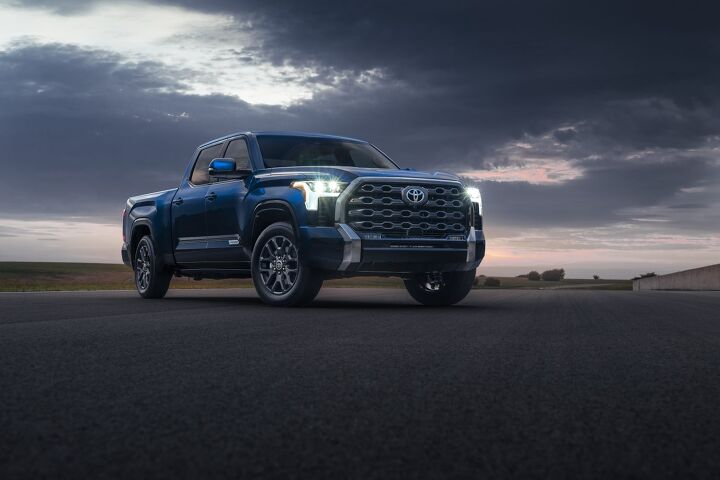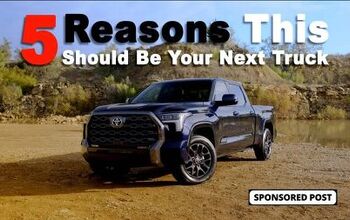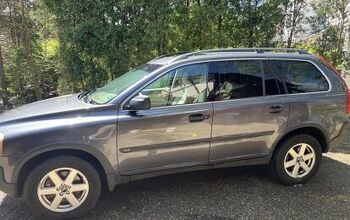2022 Toyota Tundra: We Ask Why

PONTIAC, MICH. — I noticed a couple of you commenters wondering why we hadn’t covered the 2022 Toyota Tundra yet.
One of you joked that we hadn’t done so because the grille is so ugly that we’d be charged with a crime.
The truth is more mundane than that — I was blindsided by its in-game reveal during Sunday Night Football and wasn’t in a position to write about it that night. And yesterday I was driving to suburban Detroit. One of the vehicles I was driving here to see: The Tundra.
So I figured I’d wait to see the truck in the flesh, so to speak. And now that I have, I have to ask — what is Toyota doing?
I am not just talking about the janky-looking grille, which looks less offensive to the eyes in person. There’s also the interior design, which looks at first glance to be carrying over the weird blocky look from the past.
Then there’s the fact that it apparently has a lower payload rating than the smaller Ford Ranger, at least in some trims.
What are we even doing here?
To be fair to Toyota, looks aren’t everything. Nor is a payload rating the only spec that matters. Maybe the truck is fantastic to drive and offers all the expected utility. But the early impressions are not great, Bob.
Here are the key specs — a standard twin-turbo 3.5-liter V6 makes 389 horsepower and 479 lb-ft of torque, and when equipped with a hybrid system that Toyota calls i-FORCE MAX, a bell-housing motor system boosts power to 437 horsepower and 583 lb-ft of torque. Either way, the transmission is a 10-speed automatic.
Towing capacity is listed at up to 12,000 pounds and a 14-inch infotainment screen is available, as is a 12.3-inch instrument screen. Toyota’s Safety Sense 2.5 driver-aid system is standard across the board. Max payload is 1,940 pounds.
Available features will include panoramic roof, heated and cooled front seats, heated steering wheel, towing aids, wireless Apple CarPlay and Android Auto, a tailgate release for the key fob, and over-the-air updates.
There will be two different four-door configurations and several bed lengths, including 5.5, 6.5, and 8.1 feet.
Toyota is using a fully boxed frame and promises more rigidity via high-strength steel while also using aluminum to reduce weight.
The suspension is multi-link with coil springs in the rear and the front is double wishbone. Twin-tube shocks front and rear are standard. Off-road trims get monotube Bilstein or FOX shocks. A rear air suspension is available on some trims. So, too, is an adaptive variable damping system.
Speaking of off-road, TRD Pro trims get a 1.1-inch front lift, front stabilizer bar, red-painted suspension parts, front skid plate, underbody armor, and all-terrain tires.
Available trim levels will be SR, SR5, Limited, Platinum, and 1794; with TRD Off-Road, Sport, and Pro packages being available.
The Tundra will go on sale later this year and be built in San Antonio, Texas. Pricing will be announced later.
Hopefully, we’ll have a good answer to what Toyota’s plan is by then.
[Images: Toyota, © 2021 Tim Healey/TTAC]

Tim Healey grew up around the auto-parts business and has always had a love for cars — his parents joke his first word was “‘Vette”. Despite this, he wanted to pursue a career in sports writing but he ended up falling semi-accidentally into the automotive-journalism industry, first at Consumer Guide Automotive and later at Web2Carz.com. He also worked as an industry analyst at Mintel Group and freelanced for About.com, CarFax, Vehix.com, High Gear Media, Torque News, FutureCar.com, Cars.com, among others, and of course Vertical Scope sites such as AutoGuide.com, Off-Road.com, and HybridCars.com. He’s an urbanite and as such, doesn’t need a daily driver, but if he had one, it would be compact, sporty, and have a manual transmission.
More by Tim Healey
Latest Car Reviews
Read moreLatest Product Reviews
Read moreRecent Comments
- CoastieLenn I would do dirrrrrrty things for a pristine 95-96 Thunderbird SC.
- Whynotaztec Like any other lease offer it makes sense to compare it to a purchase and see where you end up. The math isn’t all that hard and sometimes a lease can make sense, sometimes it can’t. the tough part with EVs now is where is the residual or trade in value going to be in 3 years?
- Rick T. "If your driving conditions include near-freezing temps for a few months of the year, seek out a set of all-seasons. But if sunshine is frequent and the spectre of 60F weather strikes fear into the hearts of your neighbourhood, all-seasons could be a great choice." So all-seasons it is, apparently!
- 1995 SC Should anyone here get a wild hair and buy this I have the 500 dollar tool you need to bleed the rear brakes if you have to crack open the ABS. Given the state you will. I love these cars (obviously) but trust me, as an owner you will be miles ahead to shell out for one that was maintained. But properly sorted these things will devour highway miles and that 4.6 will run forever and should be way less of a diva than my blown 3.8 equipped one. (and forget the NA 3.8...140HP was no match for this car).As an aside, if you drive this you will instantly realize how ergonomically bad modern cars are.These wheels look like the 17's you could get on a Fox Body Cobra R. I've always had it in the back of my mind to get a set in the right bolt pattern so I could upgrade the brakes but I just don't want to mess up the ride. If that was too much to read, from someone intamately familiar with MN-12's, skip this one. The ground effects alone make it worth a pass. They are not esecially easy to work on either.
- Macca This one definitely brings back memories - my dad was a Ford-guy through the '80s and into the '90s, and my family had two MN12 vehicles, a '93 Thunderbird LX (maroon over gray) purchased for my mom around 1995 and an '89 Cougar LS (white over red velour, digital dash) for my brother's second car acquired a year or so later. The Essex V6's 140 hp was wholly inadequate for the ~3,600 lb car, but the look of the T-Bird seemed fairly exotic at the time in a small Midwest town. This was of course pre-modern internet days and we had no idea of the Essex head gasket woes held in store for both cars.The first to grenade was my bro's Cougar, circa 1997. My dad found a crate 3.8L and a local mechanic replaced it - though the new engine never felt quite right (rough idle). I remember expecting something miraculous from the new engine and then realizing that it was substandard even when new. Shortly thereafter my dad replaced the Thunderbird for my mom and took the Cougar for a new highway commute, giving my brother the Thunderbird. Not long after, the T-Bird's 3.8L V6 also suffered from head gasket failure which spelled its demise again under my brother's ownership. The stately Cougar was sold to a family member and it suffered the same head gasket fate with about 60,000 miles on the new engine.Combine this with multiple first-gen Taurus transmission issues and a lemon '86 Aerostar and my dad's brand loyalty came to an end in the late '90s with his purchase of a fourth-gen Maxima. I saw a mid-90s Thunderbird the other day for the first time in ages and it's still a fairly handsome design. Shame the mechanicals were such a letdown.





































Comments
Join the conversation
If the truck manufacturers' could give a little more effort they could increase the size of the grills even more and offer 12" or more sized font in LED lighting on the grill and the tailgate. How about raising the height by at least another 6" to 12" and offer drop down ladders to enter the cab. Maybe widen the vehicles by at least another 6" and offer a front plate that says "Eat Me" (Animal House).
A 2021 (not 2022) Toyota Tundra has remarkably similar fuel economy to my 1995 C1500 [apples to apples, current methodology]: https://fueleconomy.gov/feg/Find.do?action=sbs&id=12210&id=43010 The 2021 Tundra of course is vastly more capable than my 20th century dinosaur, with significantly more torque and over twice the horsepower. (The Tundra also weighs roughly 35% more.) Perhaps I am the only truck owner on the planet who would have preferred to see a somewhat smaller bump up in horsepower and torque over 2-1/2 decades, combined with a significant improvement in fuel economy. (Perhaps the polar bears would side with me, but who is listening.) Toyota may be taking steps in the right direction with the 2022 model - will withhold judgment until the 2022 fuel economy [and curb weight] figures are published.